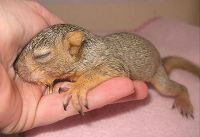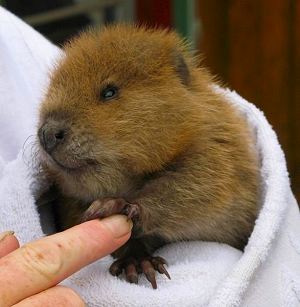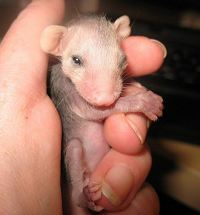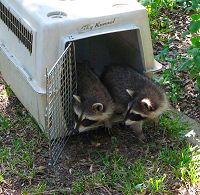Jul 15, 2010
Animal Rescuers Answering Machine Message
Press 1 if you think we are veterinarians and want free medical advice.
Press 2 if you know we are a rescue organization but want to save money and have us give you free, untrained medical advice anyway.
Press 3 if you make $200,000 a year but still want us to pay to spay the "stray" in your yard (house).
Press 4 if you have a 10-year-old dog and your 15-year-old son has suddenly become allergic and you need to find the dog a new home right away.
Press 5 if you have three dogs, had a baby and want to get rid of your dogs because you are the only person in the world to have a baby and dogs at the same time.
Press 6 if your dog is sick and needs a vet but you need the money for your vacation.
Press 7 if you just got a brand new puppy and your old dog is having problems adjusting so you want to get rid of the old one right away.
Press 8 if your little puppy has grown up and is no longer small and cute and you want to trade it in for a new model.
Press 9 if you are elderly and want to adopt a cute puppy who is not active and is going to outlive you.
Press 10 if your relative has died and you don't want to care for their elderly dog because it doesn't fit your lifestyle.
Press 11 if you are moving today and need to immediately place your 150 pound, 8-year-old, unneutured, aggressive dog.
Press 12 if you want an unpaid volunteer to come to your home today and pick up the dog you no longer want.
Press 13 if you have been feeding and caring for a "stray" for the last three years, are moving and suddenly determine it's not your dog.
Press 14 if you are calling at 6 a.m. to make sure you wake me up before I have to go to work so you can drop a dog off on your way to work.
Press 15 to leave us an anonymous garbled message, letting us know you have left a dog in our yard in the middle of January, which is in fact, better than just leaving the dog with no message.
Press 16 if you are going to get angry because we are not going to take your dog that you have had for fifteen years, because it is not our responsibility.
Press 17 if you are going to threaten to take your ten year old dog to be euthanized because we can't get to your house in the next hour.
Press 18 if you're going to get angry because the volunteers had the audacity to go on vacation and leave the dogs in care of a trusted volunteer who is not authorized to take your personal pet.
Press 19 if you want one of our perfectly trained, housebroken, kid and cat friendly purebred tiny dogs that we have an abundance of.
Press 20 if you want us to take your dog that has a slight aggression problem, i.e. has only bitten a few people and killed your neighbor's cats.
Press 21 if you have already called once and been told we don't take personal surrenders but thought you would get a different person this time with a different answer.
Press 22 if you want us to use space that would go to a stray to board your personal dog while you are on vacation, free of charge, of course.
Press 23 if it is Christmas Eve or Easter morning and you want me to deliver an eight week old puppy to your house by 6:30 am before your kids wake up.
Press 24 if you have bought your children a duckling, chick or baby bunny for Easter and it is now Christmas and no longer cute.
Press 25 if you want us to take your female dog who has already had ten litters, but we can't spay her because she is pregnant again and it is against your religion.
Press 26 if you're lying to make one of our younger volunteers feel bad and take your personal pet off your hands.
Press 27 if your two year old male dog is marking all over your house but you just haven't gotten around to having him neutered.
Press 28 if you previously had an outdoor only dog and are calling because she is suddenly pregnant.
Press 29 if you have done "everything" to housebreak your dog and have had no success but you don't want to crate the dog because it is cruel.
Press 30 if you didn't listen to the message asking for an evening phone number and you left your work number when all volunteers are also working and you are angry because no one called you back.
Press 31 if you need a puppy immediately and cannot wait because today is your daughter's birthday and you forgot when she was born.
Press 32 if your dog's coat doesn't match your new furniture and you need a different color or breed.
Press 33 if your new love doesn't like your dog and you are too stupid to get rid of the new friend (who will dump you in the next month anyway) instead of the dog.
Press 34 if you went through all these 'presses' and didn't hear enough. This press will connect you to the sounds of tears being shed by one of our volunteers who is holding a discarded old dog while the vet mercifully frees him from the grief of missing his family.
Author Unknown
Jun 30, 2010
FUNDRAISER for Teaching Facility
FUNDRAISER: Wildlife Office, Triage and Teaching Facility
The Rainbow Wildlife Rescue (RWR) continues to grow - beyond our own walls in fact. In light of the recent affiliation with the Tarleton State University R.E.A.L. (Real-world Experience Applied to Learning) program we have accomplished one of our main goals to expand our wildlife education program. The opportunity benefits all those involved and we are very excited! Beginning this fall the RWR will offer internships to students participating in the R.E.A.L. program.
As RWR grows so does the number of public visitors who often arrive unannounced and at all hours of the day and night. In short, RWR is in desperate need of physical expansion to allow for a formal office and proper animal care wards.
RWR explored 3 solutions:
1) move to a bigger place
2) close the rescue
3) get an affordable office separate from the residence and the animal care wards (by law, we must keep the public away from animals being rehabilitated)
Solution #1 is not presently viable, neither is solution #2. That leaves option #3 and the purpose of this letter.
RWR has researched portable buildings and determined that this structure would adequately suffice and be a tremendous benefit to our cause. It is 12x24 feet in size and will cost $5,000.
Here is an example (click on the thumbnails to view a larger version of the image):
 |  |
 |  |
The interior and electrical tasks could be turned into project opportunities for shop classes. We are exploring community involvement such as this.
This office will provide space for basic office furniture, equipment, and a table with a chairs for interning students. A portion of the building will be separated and used for emergency triage area for new arrivals of distressed animals. One wall will be nursery incubators and cages with critical heating pads.
The goal is to raise $5000 to purchase the building and explore classes or groups that are interested in the interior projects including electrical and hopefully some plumbing.
The Rainbow Wildlife Rescue INC is a 501(c)3 nonprofit charity organization and all donations are tax deductible.
Everybody that donates more than $25 for this "Wildlife Office, Triage and small Teaching Facility" fundraiser will receive a FREE gift!
May 9, 2010
Can I keep it?
| |||
Disclaimer: The information provided in this article is the property of the Rainbow Wildlife Rescue. The RWR holds all copyright interests in such material, unless specifically indicated. Permission to reprint is given with credit to the Rainbow Wildlife Rescue and noted authors. | |||
Apr 20, 2010
Facts and Stats about Rabies
FAQs about Rabies in Erath County, Texas
1. What exactly is rabies?
Answer:
Rabies is a contagious virus that can cause death in people and certain animals and is nearly always fatal if not treated in a timely manner.
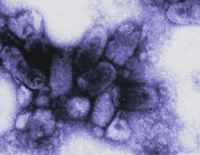
2. How is rabies transmitted?
Answer:
The rabies virus is usually transmitted through the saliva of an infected animal, most commonly through a bite. The virus can be transmitted from animal to animal, from animal to human, and on rare occasions, from human to human.
Another way of transmitting the virus, even though highly uncommon, is for saliva or brain tissue from a rabid animal to get directly into the eyes, nose, mouth or open wound of a person or animal.
However, contrary to common belief, you can’t get rabies from the blood, urine, or feces of an infected animal.
During my survey, I noted another misconception about rabies transmission. It is not true that an animal can be just a carrier of the rabies virus and transmit it to another animal or humans for weeks, months or even years.
According to the CDC, "No person in the United States has ever contracted rabies from a dog, cat or ferret held in quarantine for 10 days."
Before the rabies virus reaches the brain, the animal does not show any symptoms, according to the CDC. The animal does not appear ill during this time, called the incubation period, which may last for weeks or months. During this time period the animal CAN NOT transmit the virus to another animal or person. This is the reason why animals that have bitten a human are held in quarantine for 10 days.
As the CDC states, " Only late in the disease, after the virus has reached the brain and multiplied there to cause an encephalitis (inflammation of the brain) does the virus move from the brain to the salivary glands and saliva."
3. What animals are most likely to have rabies?
Answer:
All mammals can get rabies. It is most common in un-vaccinated household pets such as dogs, cats and ferrets as well as in livestock such as cattle, and wild animals like skunks, bats, raccoons, coyotes and foxes.
Small animals like mice, rats, squirrels, and even opossums, are almost never found to be infected with rabies. According to the Centers for Disease Control and Prevention, bites by these animals are usually not considered a risk of rabies unless the animal was sick or behaving abnormally and rabies is a major problem in your vicinity.
4. How common is rabies in Erath County?
Answer:
Officially confirmed rabies cases from 2000 until today include according to the Texas Department of State Health Services Infectious Disease Control Unit:
| Year | Rabies Cases | Confirmed In | Variant |
| 2000 | 24 | 23 skunks, 1 cat | Skunk |
| 2001 | 27 | 27 skunks | Skunk |
| 2002 | 8 | 6 skunks, 1 goat, 1 horse | Skunk |
| 2003 | 10 | 8 skunks, 2 dogs | Skunk |
| 2004 | 4 | 2 skunks, 1 bat, 1 cattle | Skunk, Bat |
| 2005 | 5 | 3 skunks, 1 cat, 1 cattle | Skunk |
| 2006 | 2 | 1 skunk, 1 dog | Skunk |
| 2007 | 4 | 3 skunks, 1 cat | Skunk |
| 2008 | 6 | 3 skunks, 2 dogs, 1 raccoon | Skunk |
| 2009 | 5 | 3 skunks, 1 cat, 1 raccoon | Skunk |
All animals except 1 (the bat in 2004) contracted the virus from an infected skunk.
5. How can I tell if an animal has rabies?
Answer:
The symptoms are not easily recognized because other diseases display similar symptoms. Pets infected with the rabies virus act in unusual ways. Be alert for changes in behavior. A dog that is friendly may avoid people. Mean dogs may act friendly to strangers. Animals may become aggressive, make strange noises or erratic movements, and attack other animals or humans. They may have trouble walking, drinking, swallowing, or chewing. It may not be able to close its mouth, and may appear to be choking. If you see an animal acting like this, call the local animal control agency right away.
6. What should I do if I had contact with a possibly rabid animal?
Answer:
Prompt treatment is required to prevent a rabies infection. First, flush the bite or wound area with water for at least one full minute. Follow up by washing with soap (or detergent if soap is not immediately available) to remove saliva containing the virus. Then apply a disinfectant such as rubbing alcohol, bleach, or iodine tincture directly on the wound and under skin flaps to stop the rabies from being absorbed into the body tissue. Then get to your doctor or an emergency room as soon as possible.
7. How is rabies diagnosed in animals and humans?
Answer:
A direct fluorescent antibody test (dFA) is used to test the brain tissue of animals suspected to be rabid. However, the dFA test can only be performed after the animal has died. For humans, several tests are required to diagnose rabies. Samples of body tissues and fluids - saliva, spinal fluid, serum, and hair follicles - are tested for signs of the rabies virus. Positive results from one test is not proof of rabies, all tests are required for diagnosis.
8. Can baby animals have rabies?
Answer:
Babies born to a healthy rabies-free mother will be rabies free at birth. Babies born to a rabid mother will most likely have rabies, because it is exposed to the mother’s saliva. These babies will probably not survive long enough to go out into the world. Teach your children to never touch wildlife. Call the authorities or your local wildlife rehabilitator if you find a wild baby animal that seems to be orphaned and in need of human intervention.
9. How do I protect myself and my pets from rabies?
Answer:
- Have a veterinarian vaccinate your dogs and cats against rabies. By law, you need to do this every year, or every three years, depending on the type of vaccine used.
- Keeping your pets vaccinated protects you and them.
- Keep pets away from wildlife and don’t let them wander loose through the neighborhood.
- Avoid contact with wild animals and with dogs and cats you do not know. Do not try to hand-feed wild animals and do not keep them as pets.
- Do not touch sick or injured animals. Call and report them to the authorities.
10. How do I prevent the spread of rabies?
Answer:
Be a responsible pet owner and have all your pets vaccinated once a year.
- Keep your pets confined and supervised.
- Spay or neuter your pets to prevent the spread of unwanted and unvaccinated animals straying through your neighborhood.
- Enjoy wild animals such as raccoons, skunks, and foxes from afar. Do not handle, feed, or attract wild animals with open garbage cans or litter. Do not leave pet food outside!
- Do not rescue wild animals or bring them into your home. Do not try to raise orphaned wildlife. Call animal control or your local wildlife rehabilitator for assistance.
Provide your pets and livestock with rabies vaccine as advised by your family veterinarian. Keep rabies pet vaccines current.
Keep pets away from wildlife and don’t let them wander loose through the neighborhood.
Contact the proper authorities if you see an animal acting strangely. Never attempt to catch or touch the animal unless you are trained.
If your pet is bitten by an animal, call the animal authorities and take your pet to the vet.
If a person is bitten by an animal (whether it is from a wild skunk caught foraging in the trash or a nip on the hand from a neighbor’s pet), clean the wound thoroughly and go to your doctor or medical clinic for treatment. Contact the authorities who will try to capture the animal for testing or quarantine.
Keep contact information handy for notifying the proper authorities about a possible rabid animal in the neighborhood.
Information and research provided by Birgit Sommer, licensed wildlife rehabilitator in the State of Texas and Director of the Rainbow Wildlife Rescue.
Sources:
Additional information:
When it comes to rabies, ignorance can kill. Not just you or your pets, but innocent and healthy wildlife. Raccoons are the number one wild animal killed for rabies testing. Dogs and cats top the list of domestic animals killed for rabies testing. In both these and other animals, the vast majority are found NOT to have rabies.
They must pay with their lives because people have possibly been exposed to rabies by them. If these same people had taken precautions against possible exposure to rabies, these animals would still be alive. Don't be responsible for the death of an innocent animal. Learn about rabies and learn how to protect yourself, your family, your pets and our wildlife.
Raccoon rabies is a strain of rabies carried mainly by raccoons. Raccoon rabies is rabies. It can be spread to farm animals, pets and people through the saliva of an infected animal in the same ways as other strains of rabies. Raccoon rabies kills raccoons, other animals and humans in the same way as other strains of rabies do. The only difference is that it is spread primarily by raccoons.
Apr 9, 2010
Rehabber Prayers
by Susan Saliga
Give us strength today we pray,
And light our path along the way.
Lend our hands Your healing touch,
For wildones that need us much.
We ask for hope and courage too.
Help us know what’s best to do.
You’ve led them here into our care,
Please help us ease the pain they bear.
When weariness invades our souls,
And sleepless nights take their toll,
Bathe us with Your healing Light
And lift us gently with Your might.
Give us faith to set them free.
To earth and water, to sky and tree.
And if You call them back to stay,
Ease their passage home we pray
A Rehabbers Prayer
by Joan Holland
Heavenly Father I ask Thee
to guide my hands this day,
To carry the weak, heal the sick
I take home with me today
This little helpless creature
that depends on me for life
doesn't understand my feelings
as I stand in vigel hours
waiting for some sign of life
Grant me wisdom and mercy
as I do right by them today
oh, Lord firgive my lack of knowledge
I do the best I can, I pray
Thank you Lord, for this small life
I hold now in my hand,
that You will show him mercy
and allow him to survive.
Apr 6, 2010
Project Saving Stephenvilles Wildlife
This is what it is all about (and what I read to the city council):
While at the local animal shelter I have observed our Animal Control Officers bringing in traps with healthy adult raccoons and other wildlife, which are often needlessly euthanized.
Naturally, being licensed by the State to provide assistance to State owned wildlife, I started wondering if there is any way to save these animals without causing more work.
Due to facility restraints at the Rainbow Wildlife Rescue I am not capable of offering to take all these animals in, however, I have come up with a solution that I am confident will benefit all involved.
I am authorized to legally transport raccoons within 10 miles from where they were collected. We have ample and appropriate release sites that are carefully selected and within the legal limits. I am extremely diligent in matters of potential overcrowding and do not release more than 10 animals of each species at any given site per year.
Our plan is to install trail cams and microchip the relocated animals to assist in a State research project on relocation adjustment, as well as support the USDA sponsored TVR (trap-vaccinate-release) program. This will provide a further service in vaccinating wildlife against rabies and providing effective data.
To implement this effort the Rainbow Wildlife Rescue would allow the Animal Control Officers to drop off healthy trapped animals away from the public shelter at our Clifton Street facility, which is less than ½ mile from the shelter.
I will provide a secure enclosed area that's easily accessible to the officers where they will simply leave the animal remaining in the trap and take an empty trap back with them, which will also be provided.
I then will evaluate the animal and upon finding it suitable for release will proceed with the program as stated, or take the necessary steps to have the animal humanely euthanized.
This will save the city and the officers time, effort, supplies, money and completely prevent physical exposure, handling and euthanizing these animals while a the same time providing useful information to science and research.
I can accept raccoons, opossums, rabbits and squirrels for relocation. I will not accept skunks, foxes, bats, deer or coyotes.
I am looking forward to your support and am prepared to implement the simple steps needed to begin.
Feb 19, 2010
Wildlife Rehabilitation in America
Wildlife Rehabilitation in AmericaWhat is a wildlife rehabilitator?A wildlife rehabilitator is a person licensed by their State to take in orphaned and injured wildlife for the general public, as required by the State. Orphaned baby animals will be raised properly and injured or ill critters are rehabilitated. Your main responsibility is to the animals you are caring for. The goal is to get these animals back into the wild where they are supposed to be, and want to be. That's what it is all about...the animals remaining wild. Wanting them to be pets is not what they want! Working with wildlife is very different from working with domesticated pets. Where it's ok to hold an orphaned kitten or puppy to comfort it when it's missing it's mother, it's not ok to hold a cottontail rabbit for example, because it can die of fear in an instant. Keeping handling and human exposure to a minimum is vital for the animals' survival in the wild later on. How do you get the animals?We receive calls from people like you who came across an animal that appeared to be in need of human intervention. We often receive animals from the local Animal Control Agencies, Game Wardens, Businesses, Police Departments, Sheriff Offices, Veterinary Clinics and Animal Shelters. Why do animals end up with a wildlife rehabber and what kind?Animals end up with a wildlife rehabilitator for various reasons. It can be a baby squirrel that fell out of a nest, usually after a storm, and found by school kids; a songbird that flew into a window and has a concussion and needs a safe place to recover; an opossum mother hit by a car with living babies in the pouch that caring individuals saved and brought to us; a baby raccoon sitting next to his dead mother on the side of the road crying; the litter of cottontail rabbits whose mother fell victim to a lawn mower or a wild animal hurt by our dogs and cats...the stories are endless. What do you do with them?In the case of infant critters where a re-union with the mother has been ruled out, they will be raised and taught how to relate to others of their species, given a chance to develop their survival skills, know what their predators are, and how to find food and shelter before they will be released back into the wild. What about injured animals? Do you have medical training?Even though wildlife rehabilitators have to go through training and study as much as possible, they are not veterinarians and have to seek professional medical assistance in case of an injured animal, such as an owl with a broken wing or a deer hit by a car with a leg fracture; a raccoon caught by a dog covered in bite wounds; a squirrel with bb gun pellets in its back...again, the stories are endless. Unfortunately not every vet clinic is willing or capable of assisting wildlife rehabilitators with these animals for various reasons. If the injuries are too severe, the only option left is to euthanize the animal to shorten their suffering. What else does a wildlife rehabber do besides caring for wildlife?Another important part of being a wildlife rehabilitator is dealing with the public. Once spring starts and the first animals of the season, usually squirrels, are being born, the calls are coming in about pink hairless babies found on the ground. There are a lot of caring folks out there that go the extra mile to help out that infant and take it to a licensed wildlife rehabilitator or wildlife facility. A lot of people attempt to care for these animals on their own and only call us when they see that their approach didn't work. Sadly, at that point it is often too late for us to help. Many folks proudly explain all the things they have done wrong, believing they did everything right, which doesn't make it necessarily easy to educate them without coming across as criticizing. Busting old wife's tales takes a lot of our time, that is why I am here now. We often get calls from rude people that are trying to threaten or ridicule us, seem to enjoy grossing us out with the gory details of their hunting stories, or tell us they will kill the animal if we don't come right now and pick it up. Fact is that most of us home based rehabilitators can't just rush out and drive around to pick up animals. Who will take care of the critters we already have? The focus has to be on the animals already there. We are happy to take in critters, but we are so grateful when people can bring them to us. We simply don't have the resources to do everything they expect us to do, but the majority of people that call want to help and don't mind the transporting the critter. Can I make a lot of money being a wildlife rehabilitator?Most wildlife rehabilitators these days are home based. We can't charge for anything we do because these are State owned animals, so we survive strictly on donations. If you are in this for the money you will be disappointed. It's a life style, a passion and a commitment, and most rehabilitators front the bills out of their own pockets and don't get paid anything. Some things just can't be weighed in money...but knowing at the end of the day that you are doing the right thing is more rewarding than a fancy car to most of us. Wildlife Rehabilitation used to be more of a hobby than a profession back in the days, but times and laws have progressed. The government requires us to be trained in order to obtain the necessary permits, provide proper facilities which are subject to inspection in most states, provide release sites, even pay for our own pre-exposure rabies shots. Fortunately, more national and international organizations are working on research and studies benefiting our local wildlife, and offer rehabilitators extended training courses. Some rehabilitators establish a wildlife center in their area, usually a nonprofit based organization because the government does not financially support wildlife rehabilitation. Yet. That's why there are not many independent wildlife facilities in America, most are connected to colleges or vet clinics, so paid jobs in this field are still hard to find. How do I get a wildlife rehabilitation permit?There are permits you have to obtain from your State for mammal rehabilitation. If you also want to rehabilitate birds, you will need a federal permit from the US Fish and Wildlife in addition to the State permit. That's for nearly all types of birds from songbirds to birds of prey. Different agencies are responsible for issuing wildlife rehabilitation permits and requirements also vary from state to state. In some states the department of natural resources is in charge of wildlife rehab permits, in other states it's the parks and wildlife department or fish and wildlife commission. You will find direct links to each State's application on our website at www.wildlife-education.com . In almost all states it is illegal to take an animal out of the wild and attempt to treat it on your own, no matter what your motives are. Even if you plan to release it later on back into the wild, it's most likely not going to happen if you don't know what you are doing. Can everybody become a wildlife rehabilitator?As a wildlife rehabber you have to be a very strong and determined person. There is a lot of frustration involved when dealing with the public and administrative side of this vocation. It's about hard work, long hours, no weekends or holidays and never enough money, and also a lot of emotional and heartbreaking cases where you have done everything you can but still can't save an animal. All we can do then is to provide a warm, safe place for an animal to die. However, being able to work with wild animals that most people don't even get to see up close, to touch them safely, heal them, and see them be free again…that is a privilege to most rehabbers. Knowing they made a difference and got this animal back to where it belongs is worth all the efforts, expense, and even the heartaches. How much does it cost?In addition to the required permits you will need a lot of items ranging from inside cages and incubators to outside enclosures and habitats. You'll be using medical supplies, syringes, nipples, wound care supplies, bottles, feed, blankets, towels, educational material, different formulas for different species, bedding, building supplies, volunteers, fundraising skills, time for education, and not to forget your own family and social life. In other words, a LOT! It really helps if you are good with basic business skills so you can be professional in what you do with the public, organize fundraising events and such. Be proudSome folks find the idea of wildlife rehabilitation ridiculous or claim it's "messing with nature". These folks neglect to see that most wildlife related calls that require our human intervention ARE the direct result of unnatural conditions such as careless behavior of people, toxins, poisons, automobiles, guns, traps, lawn mowers, to name just a few. Often we are confronted with animals that have suffered traumatic wounds and horrific injuries. Some animals come in poisoned, shot, injured by cars and left for dead by humans. The stories and cases are endless and heartbreaking. THAT is called “messing with nature” and careless humans do it everyday, whether we mean to do harm or not. We, as wildlife rehabilitators, are dedicated warriors on the front lines between suburban development and natural habitat and are grateful for every bit of support we can get. Thank you! |
Feb 8, 2010
Raccoon Illegal Possession Survey
Please everybody, fill this out. You will remain ANONYMOUS!
Feb 2, 2010
Wildlife in the Classroom Fundraiser
 | |||||
| |||||
| Teachers join the Rainbow Wildlife Rescue - Educational programs are under development - Outdoor cameras needed to stream video from the animal habitats live into the classrooms - Laptop or netbook needed for recording video and images and classroom presentations. | |||||
This year is starting out very promising! After gaining the 501(c)3 status from the IRS we are in the process of forming a board of directors/trustees. In addition we welcome our first Wildlife Assistant Rehabilitator and sub-permittee Loree Behymer who will be in charge of the squirrels this year.
The highlight of our educational program will be cameras installed in the animal enclosures streaming videos and images of different native wildlife species live into the classrooms. The kids can observe these animals throughout the day and collect data on them. This aligns with the state Science TEKS particularly with 5th grade and below.
The videos and images will be viewable to everybody on the internet through our Rainbow Wildlife Rescue website, including you, not only the classrooms which however are the number 1 priority. Here is an example of a live squirrel cam: http://lpyardcams.camstreams.com/ Please help us get "Wildlife in the Classroom" program into place. | |||||
Rainbow Wildlife Rescue
If you would like to become a sponsor of the Rainbow Wildlife Rescue or have contributed in the past and would like your name to be added to our Thank You page, please click HERE. If you like to make a contribution or think you have items that we could use, please visit our Donation page to view our wishlist. |
Jan 17, 2010
Teachers join the Rainbow Wildlife Rescue
But that's just the tip of the iceberg! 3 teachers from Gilbert Intermediate School in Stephenville have visited the Rainbow Wildlife Rescue and want to become actively involved ranging from joining the board of directors to assisting in fundraising, receiving basic wildlife care training, and most importantly develop educational programs to get the kids involved. This would make one of my lifelong dreams come true! Stay tuned for the introductions.
The highlight of our educational program will be web cams in the enclosures streaming live pictures of the animals into the classrooms. The kids can observe these animals throughout the day and collect data on them. This would align with the state Science TEKS particularly with 5th grade and below.
Usually these animals are seen dead on the side of the road but students rarely observe them alive, watching them eat or learning where the sleep. The benefit of having the kids watch the webcam in class would hopefully show them how much amazing wildlife is in their own area.
The students taking the TAKS test will be asked some questions relating to their state and the animals/plants that grow here. If they have never been able to observe an animal in it's habitat it's hard for them to relate.
In order to achieve this goal we are in need of 4 outdoor webcams or security cams that can operate wireless and on batteries and are capable of streaming video over the internet. In addition we need a laptop or netbook to record the pictures and transport data and presentations to schools and other educational demonstrations.
If you would like to help us out in any way, please click HERE!
Thank you in advance.
Jan 15, 2010
Top Most Common Pet Poisons of 2009
Is your pooch mad for people food? Does your kitty like to self-medicate? Sadly, not everything we love is good for us. In fact, many common household goods that we take for granted as harmless can poison our furry friends. In 2009, the ASPCA Animal Poison Control Center in Urbana, IL, handled more than 140,000 cases of pets exposed to toxic household substances, including insecticides, cleaning supplies and prescription medications.
To help you keep your pet safe and sound in 2010, our experts have created a list of the 10 common poisons that most affected our furry friends last year. Here’s a sneak peek at their advice:
- Top dishonors—once again—go to human medications, which accounted for the most calls to the ASPCA’s 24-hour poison control hotline in 2009. Pets often snatch pill vials from counters and nightstands or gobble up meds accidentally dropped on the floor. Remember to keep all medications, including pain remedies, antidepressants and decongestants, in a cabinet far away from pets’ prying paws.
- Cats and dogs are often the unwitting victims of our efforts to battle flea infestations. The misapplication of spot-on flea and tick products can be especially problematic for our feline friends. Talk to your vet about choosing the right, species-specific flea treatment for your pet and never use products made for dogs on cats, and vice versa.
- Some of the most delicious people food—including citrus, avocado and raisins—can be poisonous to pets. Chocolate ingestion accounted for nearly half of all people food-related cases in 2009, so be sure to keep cocoa hidden from your resourceful cat or dog.
- Pet parents also need to remember to protect their cats and dogs from common household cleaners such as bleaches, detergents and disinfectants. These products, when inhaled by our furry friends, can cause serious gastrointestinal distress and irritation to the respiratory tract.
- Household plants may keep your house green and your air clean, but some can cause serious gastrointestinal problems for companion animals who nibble on them. Check out our toxic plant list before your next visit to the nursery.
As always, if you suspect your pet has ingested something toxic, please call your vet or the ASPCA’s 24-hour hotline at (888) 426-4435. To read our complete list of the 10 most common pet poisons of 2009, visit APCC online.
How to rehabilitate a scared Puppy

1. Do not ever pity a dog. Most dog owners make the mistake and apply human psychology to a dog by talking to them in a high pitched baby voice and offering affection or treats in the attempt to provide comfort to the fearful canine. This only reinforces the fear and teaches the dog that it's ok to be scared. He even gets rewarded for it with affection and treats. That's obviously not the message we want the dog to get.
2. Do not feed into the fearful behavior, ignore it. Instead wait for him to show the slightest hint of courage and brave behavior, then praise him.
3. Provide the dog with as much socialization and exposure to new things as you can, always in a calm and assertive manner.

4. You've probably heard it from the Dog Whisperer Cesar Milan before: No Touch, No Talk, No Eye Contact.
Make sure your guests understand that they need to completely ignore the dog until he makes contact on his own, usually by sniffing. Even then they need to avoid eye contact, do not bend over the dog which appears as a threat to most canines, and pet the dog under the chin and chest instead of the top of the head. This is the hardest part of all..getting humans to understand that they do not do the dog a favor by feeling sorry for him and forcing their affection on them.
5. The power of the pack works every time because learning from other dogs that are balanced is much more effective than any human effort could accomplish.


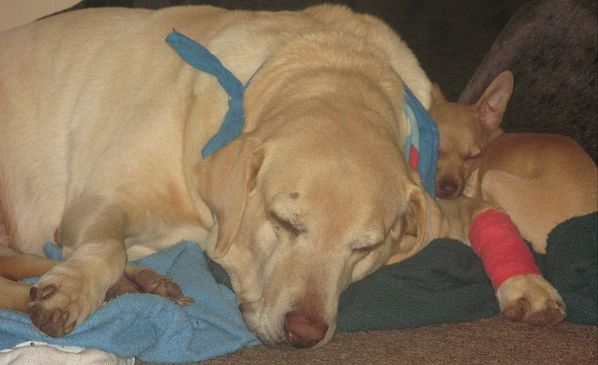
Jan 12, 2010
Doogle, Chihuahua, abused, neglected, mistreated, rescued
Doogle was kept in a small round bird cage hanging off the ceiling in a run down puppy mill and then dumped over the animal shelter's fence in the middle of the night about a year ago. He couldn't even walk.
Had no clue how. After his rehabilitation, which took 2 surgeries and a lot leadership to give this little 3 lbs guy some confidence, he has come around nicely and lives with 2 Great Danes and a Labrador at the Rainbow Wildlife Rescue in Texas, his forever home. We are considering teaching him some more tricks and taking him to schools to teach kids how to take proper care of their own pets. GO DOOGLE DUCK GO!
Jan 11, 2010
Items needed for Education and Schools
One of the highlights in this program will be outdoor cams transmitting pictures of the animals in our care live into the classrooms.
But for that we need the cams and a laptop computer.
Here is a list of top priority items we need:
- A laptop or netbook computer for educational, administrative and presentation purposes.
- 4 wireless battery-powered outdoor webcams for the enclosures to be transmitted straight into classrooms.
- Fencing Material (lattice, privacy panels, chain link, fence posts and poles, concrete)
- Green House Frame for a flight cage for songbirds (minimum size 6' width, 8' length, 8' height)
- Pick-up Truck or Van for Animal Transport and Rescue Missions
All our sponsors will be featured on our Sponsor page!
Further we have planned to pick up some of the over 26000 animals that have been seized in Arlington, TX from US Globals Exotics. While it is not determined what kind of animals we'll be bringing home or even when exactly, the purpose of them will be educational as described above.
That also means we have to build more habitats and fences to keep these animals secure. Any help with items, funds or if you are handy, your time helping us build it all, will be much appreciated!
Jan 10, 2010
Laila was adopted!

Jan 7, 2010
26,411 Exotics seized
http://www.spca.org/site/News2?page=...iv _ctrl=1481
http://ow.ly/T3Tg
City of Arlington Awarded Custody of 26,411 Reptiles, Insects, Arachnids, Crustaceans and Mammals
Wednesday, January 6, 2010
By: Jaklin Kaden
(DALLAS, TX); January 6, 2009--The City of Arlington was awarded custody of 26,411 animals--reptiles, insects, arachnids, crustaceans and mammals--seized from U.S. Global Exotics on Tuesday, December 15 under the authority of Arlington Animal Services at a hearing at the Arlington Municipal Courthouse.
Click here to download the ruling.
"The Respondents (Jasen and Vanessa Shaw) cruelly treated all of the animals made subject of this hearing by cruelly confining the animals. In particular, all of the animals were cruelly treated in one of more of the following manners: cruelly confined and injured due to such confinement; unreasonably denied necessary food and water, subjected for an extended period of time to food and/or water contaminated with foreign substances including but not limited to feces and urine…and denied necessary veterinary care," said Judge Michael Smith.
"Given that thousands of animals were clinically/subclinically sick on seizure, many will continue to suffer morbidity and mortality due to Global's abuse; veterinary treatment and other expert care can do only so much. My understanding is that Global was losing/throwing in the dumpster 500 animals--not all quite dead at the time--a day (which fits with the finding of 600 animals discovered sick/dead at the facility on the day of the seizure), and that makes 3,500 animals a week; we've certainly reduced that figure. Approximately 80% of Global’s animals were identified (by independent veterinary and other assessment) as sick and dying at seizure; whereas now approximately 80% (due to our care) are out of danger/healthy. Many of the 4,000 'listed dead since seizure' were necessarily euthanased on humane grounds; many showed truly pitiful suffering from starvation, dehydration, gross infectious disease including devastating radiating sores, partially cannibalised yet still living bodies, and many others in unsavable condition," said Dr. Clifford Warwick, one of the scientific specialists brought in to assist with the animal seizure, aftercare and testimony in court.
This case sheds light on a very dark industry that sells pets commonly sold at pet stores. Purchasers are often not aware of the horrific conditions in which these animals live. This industry is regulated, but that regulation has not prevented the suffering. Better enforcement of existing laws and regulations is critical to preventing animals from suffering this kind of abuse.
None of the animals will be available for adoption. The SPCA of Texas will place the animals with reputable organizations such as zoos and sanctuaries to ensure they do not go back into the pet trade business or are not released into the wild.
Four days before seizure, Arlington Animal Services asked the SPCA of Texas and the Humane Society of North Texas to assist with the transport and housing of these animals. This multi-agency partnership between the Arlington Animal Services, the SPCA of Texas and the Humane Society of North Texas was critical to ensuring the care of these animals until the final ruling made at the custody hearing.
Species-appropriate experts arrived from all over the world to direct the care of these animals that were seized in what is being called the largest animal rescue of exotic animals in a cruelty case ever in the United States. These experts were on hand during the seizure and while the animals are being housed.
The animals were removed from a business that specialized in shipping them to pet trade businesses globally. Hundreds of the animals were found dead, and thousands more were acutely suffering from severely overcrowded conditions, cruel confinement, lack of food and water and lack of appropriate care.
A pervasive smell of death permeated the U.S. Global’s building where the animals had been housed. Some animals, including Iguanas and turtles, had been left in packing crates without food, water or appropriate living conditions for unknown periods of time, possibly weeks. Other animals had begun to cannibalize each other, possibly due to severely overcrowded conditions and utter lack of food. Many animals may have been crushed to death by the weight of the hundreds of other animals piled on top of them in certain enclosures. In some cases, hundreds or even thousands of animals were forced to live in containers together to fight for what little food and water was available. Snakes and other reptiles were housed in areas that were far too cold while other animals were kept in individual containers so tiny that they could not move.
This massive effort has required a tremendous amount of effort, time and expense. The SPCA of Texas would like to thank the City of Arlington, the Humane Society of North Texas and the veterinarians and experts from around the world for their tremendous efforts on behalf of these animals.
"The sheer volume of animals in this seizure was unlike anything I've seen before in more than 30 years working in the animal welfare field," said James Bias, President of the SPCA of Texas. "Without the partnership between these groups, these animals would still be living in the horrific conditions they were removed from, and the loving care of the veterinarians and experts was critical to the animals' well-being."
To help the SPCA of Texas fund future rescues like this and to support the SPCA of Texas' other programs and services, please visit www.spca.org/helptheanimals. To learn more about the SPCA of Texas, please visit our website at www.spca.org.
Jan 5, 2010
How to make a Donation to the Rainbow Wildlife Rescue
| Donate using Paypal | Donate using |

Please select an amount: | OR  |
| Mail Check or Money Order to: | Order and/or send Items directly to: |
Rainbow Wildlife Rescue
| |
| Become a Member (coming soon) | Sponsor an Animal (coming soon) |
| Honor Giving (coming soon) | Buy Wildlife Merchandise (coming soon) |
| Pixel Fundraiser (coming soon) | Raffle (coming soon) |
|
|
|
| The Rainbow Wildlife Rescue is a 501(c)(3) non-profit charitable organization. All donations are tax deductible! For more information please call (254) 968-4626 or email me (Birgit Sommer) at help@rainbowwildlife.com. | |
How much does it all cost???
A LOT! The Rainbow Wildlife Rescue went through over 50 lbs of Esbilac and KMR milk replacers in 2009, that's close to $3000 alone.
We spent a lot more on medical supplies, bottles, cleaning supplies, caging, bedding, canned food, dried feed, meat and fresh produce, live food, repairs, maintenance, and not to forget the utility bills that are 3 times as high than average when the rescue is full and the phone bill, which also triples during baby season.
About 30% of the cost were covered by donations and online fundraisers. A HUGE THANK YOU to everybody that had the heart and means to support our efforts!
The remaining 70% I earned with online jobs such as web design and hosting, site maintenance, translations, article writing, graphic design, etc.
Even though I enjoy these jobs, I'd wish I could spend that time focusing on the animals and education instead of earning the money for feeding them. This is where I need your help.
The following points are a few examples of how your donation can help:
- $1000 helps with the utilities and phone bill for 3 months
- $ 500 pays for raising and vaccinating an 2 infant raccoons
- $ 250 will feed a litter of opossums from infant to release
- $ 100 will provide infant formula for 3 squirrels
- $ 50 provides bird food from nestling to adult
- $ 40 pays for a 30 lbs bag of Premium dog food
- $ 20 covers the de-wormer to fight internal parasites in 1 raccoon
- $ 10 provides fresh produce for most critters for 2 days
Top Priority Items:
- A laptop or netbook computer for educational, administrative and presentation purposes.
- Fencing Material (lattice, privacy panels, chain link, fence posts and poles, concrete)
- Green House Frame for a flight cage for songbirds (minimum size 6' width, 8' length, 8' height)
- Incubators
- Petfood and Catlitter (KMR and Esbilac Milkreplacers, Premium dog/puppy and cat/kitten food, dry and cans. Premium means that the top 3 ingredients on the label MUST contain real meat, not by-products, e.g. IAMS ProActive has real chicken as first ingredient.)
Also needed:
- Committed Volunteers, including Rehabbers & Veterinarians
- Release sites in Erath County
- 4 or 5 ft tall ferret type cages with 1/2 to 1 inch gaps
- Small and large bird cages
- Hamster cages
- Guinea pig cages
- Fish tanks with lids
- Terrariums
- Infant medical supplies
- Wild bird and sunflower seed
- Nuts, Pecans
- Pedialyte
- Storage bins with lids
- Paper towels, large trash bags, zip lock freezer bags, laundry detergent, bleach
Medical Supplies (for the Vets):
- Incubators
- Infant Amoxil
- Clavamox
- Pedialyte
- Lactated ringers
- Bene-Bac
- De-womers (Drontal, Strongid)
- Topical eye antibiotic cremes
- Wound care supplies
- Frontline, Advantage, Advantix etc
- Capstar
- Syringes with tiny needles
- Tiny feeding tubes
- IV tubes
- Pain meds
- Calming meds
- De-congestant
- Vaccinations (feline and canine)
- Anti fungal meds (oral and topical)
- Burn treatment





